Cliff Lift
The
site
of
the
cliff
lift
was
originally
occupied
by
moving
public
walkway
which
opened
in
1901.
It
was
built
by
the
American
engineer
Jesse
Reno.
This
was
called
the
“Reno’s
Electric
Stairway.”
The
contraption
at
Southend
was
the
forerunner
to
the
modern
day
escalators,
which
was
basically
wooden
slatted
steps
attached
to
a
looped
chain,
driven
by
a
diesel
engine.
The
mechanism
was
fitted
with
little
safety
measures,
surprisingly,
no
accidents
were
ever
reported.
The
cost
was
one
penny
to
be transported up the cliffs.
The
biggest
draw-back
at
the
time,
was
the
fact
there
was
no
cover
from
the
elements,
it
also
was
noisy
and
uncomfortable.
A
pitched
roof
was
added
later,
although,
the
rickety
ride
could
not
be
overcome,
the
fact
that
you
had
to
stand
the
length
of
its
journey
was
proving
unpopular
too,
this
coupled
with
reliability
issues
and
regular
stops
for
maintenance,
it
was
decided a replacement was needed.

Southend Timeline Southend-on-Sea © 2009 - 2024. All Rights Reserved

Southend-on-Sea
With
a
major
fault
occurring
on
the
cliff
lift
in
2004
the
council
decided
to
carry
out
a
major
restoration
on
the
92
year
old
railway.
After
applying
to
the
National
Lottery
in
2004,
Southend
Council
was
awarded
£1.5
million
of
Heritage
Lottery
Funding
for
the
restoration
of
the
cliff
lift
and
cliff
gardens.
Work
on
restoring
the
stations
commenced
in
October
2005,
the
restoration
of
the
two
stations
was
progressing
well
until
a
major
setback
hit
the
project
when
the
European
Union
decided
to
change
the
designation
of
the
rack
railway,
re-listing
it
as
a
cable
car.
This
change
saw
much
stricter
legalisation
for
operating
a
cable
car.
This
caused
long
delays
to
the
restoration
program
as
new
safety
measures
to
the
operating
and
breaking
systems
needed
to
be
specially
designed
and
built,
these
also
had
to
be
in
keeping
with
the
style
of
the
listed
cliff
lift.
During
this
delay
it
was
decided
to
remove
further
sections
of
the
cliff
lift
for
inspection.
After
removal
of
certain
sections
of
the
structure,
it
was
found
that
parts
inside
the
inner
structure had corroded and would need to be replaced.
The
restoration
of
the
two
stations
was
completed
in
April
2006
at
a
cost
of
£133,000.
This
saw
the
flat
roofs
replaced
by
Victorian
style
pitched
roofs
and
the
lower
stations
ramp
reduced
in
angle
to
make
it
more
disabled/buggy
friendly.
The
money
to
restore
the
cliff
lift
did
not
allow
for
any
work
on
the
mechanical
side
of
the
restoration
or
for
any works relating to the change of design for safety purposes.
In
2007
Southend
Borough
Council
allocated
£300,000
from
its
Capital
Programmes
fund
to
fund
the
works
needed
to
bring
the
cliff
lift back into operation.
In
2008
work
started
on
the
cliff
lift,
this
saw
scaffolding
erected
and
heavy
duty
tarpaulins
wrapped
around
it.
In
2009
it
was
the
turn
of
the
car
to
begin
restoration,
it
was
carefully
lifted
from
the
track
and
placed
on
to
a
specially
adapted
low-loader
so
that
the
load
remained
balanced
and
did
not
put
any
stress
on
the
antique
car.
The
rebuilt
car
returned
to
Southend
on
Monday
22nd
March
2010
the
body
of
the
car
was
completely
rebuilt
to
comply
with
all
current
disability
laws,
the
cost
of
restoring
the
car
totalled
£650,000. It was returned to the rails the following day. The body was new whilst the chassis was the original one refurbished.
2006 restored car back on its track
Ever
since
the
lift
had
opened
only
basic
stations
were
provided
at
the
top
and
at
the
bottom
of
the
cliffs.
During
a
major
refurbishment
program
in
1959,
it
was
decided
to
construct
proper
stations
with
covered
waiting
facilities,
including
seating
and
lift
call
buttons.
During
the
refurbishment
the
car
was
sent
away
and
a
new
one
was
constructed.
Further
work
during
the
1959
refurbishment
included
replacing
the
old
resistance
control
gear
with
one
built
specially
by
Ward
Lennard.
The
power
to
the
counter
balanced
carriage
was
supplied
by
a
25hp
160
volt
DC
motor
which
itself
was
supplied
by
an
A.C
three
phase
and
single
phase
generator
to the main drive which is released electro-magnetically.
The
cliff
lift
remained
popular
and
well
used
for
the
next
thirty
years,
then
in
1990
with
the
cliff
lift
reaching
78
years
old,
another
in-depth
restoration
began.
This
saw
the
car
again
being
rebuilt
(for
the
third
time)
with
the
most
notable
change being to the layout of the doors.
The
original
car
was
built
in
1912,
with
the
first
replacement
in
1930,
and
a
second
replacement
in
1959,
all
these
cars
had
entry/exit
doors
to
the
front
&
rear,
the
1990
replacement
kept
the
rear
door
but
had
the
front
door
moved
to
the
right
hand
side,
this
reduced
capacity
to
18,
but,
allowed
modifications
to
the
seafront
station,
apart
form
these
mods,
externally
the
car
is
more
or
less
aesthetically the same as the original car from 1912.
The
cliff
lift
operated
well
until
1st
August
2016
when
it
broke
down
a
few
feet
from
the
upper
station,
the
car
operator
and
three
passengers
had
a
40
minute
wait
whilst
fire
fighters
rigged
a
triple
extension
ladder
and
safety
equipment
to
rescue
the
passengers
bringing
them
out
one
at
a
time.
Afterwards,
a
team
from
the
Council
carefully
retrieved
the
car
back
to
the
station,
then
set
about
fixing the fault.
The
cliff
lift
went
back
into
service
but
during
2017
it
again
developed
a
fault
which
knocked
it
out
of
service
for
most
of
the
year.
With
the
fault
traced
and
the
repairs
carried
out,
it
was
announced
that
it
would
be
manned
entirely
by
a
team
of
volunteers.
Lift
operators
are
responsible
for
closing
and
opening
the
doors
along
with
operating
the
car
at
either
station,
the
decrease
in
speed
as
it
approaches
either
station
and
the
final
stop
is
fully
automated.
Safety
systems
include,
emergency
breaking
should
there
be
a
power
failure
and
a
safety
device
attached
to
the
doors,
should
they
be
opened
whilst
in
motion.
The
volunteers
collect
fares
and
issue
tickets.
The
summer
of
2018
will
be
remembered
for
its
long
hot
summer,
on
Monday
2nd
July
2018
the
unthinkable
happened…The
dry
grass
alongside
the
historic
cliff
lift
caught
fire,
thankfully
the
fire
brigade
were
very
quickly
on
scene,
and
were
able
to
douse the flames before it had chance to take hold.
The
Cliff
Lift
was
re-opened
by
the
Mayor
of
Southend
on
Tuesday
25th
May
2010.
The
first
major
use
of
the
restored
cliff
lift
was
the
Southend
Air
Festival just five days later.
In
2011,
the
council
announced
it
was
looking
at
volunteers
or
a
charity
to
help
run
the
cliff
lift
so
that
it
could
run
longer
throughout
the
year.
The
volunteers
would
be
given
full
training
to
operate
the
historic
structure,
whilst
the
council
would
retain
maintenance,
if
a
registered
charity
took
charge they would have been able to engage in a profit share scheme.
The
cliff
lift
continued
to
be
operated
by
the
Council
throughout
the
2011
season
and
into
2012,
on
Thursday
26th
May
2012
a
fault
developed
with
the
lift
resulting
in
it
being
out
of
action
for
the
weekend
during
the
towns
last
airshow.
The
cliff
lift
remained
out
of
action
for
three
weeks,
as
it
is
of
unique
design,
parts
cannot
be
picked
off
the
shelf,
but
need
to
be
specially
ordered,
the
cost
of
having
parts
built
and
stored
on
a
shelf
for
many
years
is
not
cost
effective,
some
parts
might
never
break,
so
having them made to order is more cost effective in the long term.
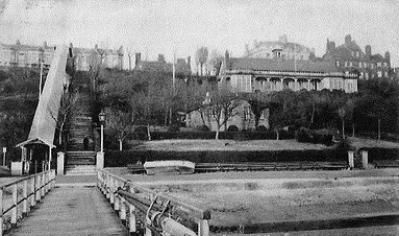
The
current
cliff
lift
was
built
by
Waygood
&
Company
in
1912.
(R.
Waygood
&
Co
Ltd
would
later
become
Waygood
Otis
Ltd,
which
in
turn
became
Otis
Elevators
Co
Ltd).
The
lift
opened
on
August
bank
Holiday
1912,
the
area
by
this
time
was
owned by the Corporation (Council).
The
lift
is
a
single
track
twin
gauge
counterweight
rack
railway.
The
car
runs
on
an
elevated
4
foot
6
inch
gauge
track
with
the
counterweight
running
on
a
1
foot
9
inch
gauge
track
below
the
car
track.
The
length
of
the
railway
is
130
feet
(40
meters)
climbing
from
the
seafront
to
cliff
top
rising
57
feet
(17
meters)
with
a
gradient
of
43.4%
(1
in
2.28).
The
car
could
carry
30
people
at
a
time,
the
traction was supplied by electric motors.
The
first
major
refurbishment
of
the
railway
came
in
1930,
this
saw
the
car
replaced,
whilst
in
keeping
with
the
original
design
the
new
car
had
room
for
30
people,
a
general
refurbishment
of
the
whole
railway
was
also
undertaken.
At
the
same
time
as
the
refurbishment
a
fairy
windmill
was
built
alongside
the
upper
station,
the
windmill
was
part
of
Never
Never
Land,
and
would
be
illuminated
at
night.
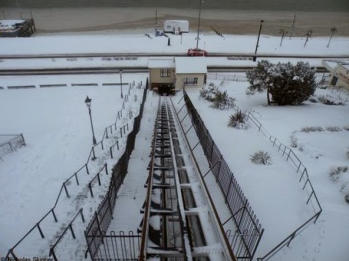
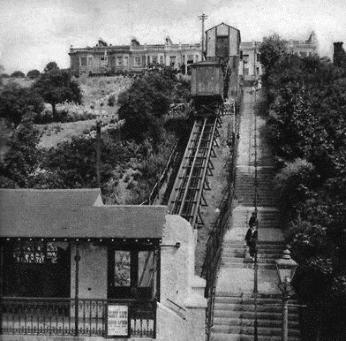
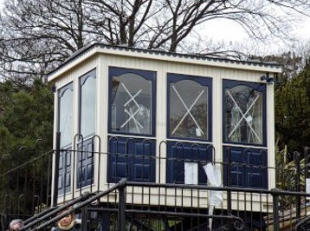
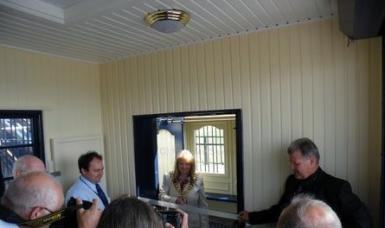
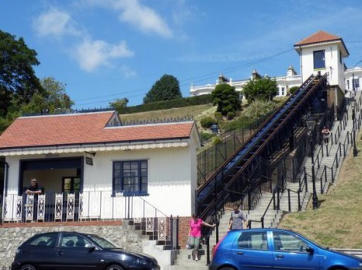

Postcard view of the Electric Stairway
Winters Day in 2016
2017 The restored Cliff Lift
2010 The Mayor Opening the Restored Cliff Lift


Southend-on-Sea’s No 1 History Website! Documenting The Town & The Townspeople

Now Incorporating The Sea Of Change Website
Website Info:


Chalkwell ▪ Eastwood ▪ Leigh-on-Sea ▪ Prittlewell ▪ Shoeburyness ▪ Southchurch ▪ Thorpe Bay ▪ Westcliff-on-Sea
SOUTHEND CITY
































































